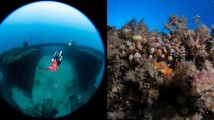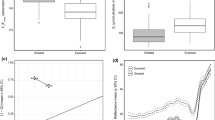Abstract
The Belizean reef coral Agaricia tenuifolia Dana forms aggregations in which rows of thin, upright blades line up behind each other. On average, the spacing between blades increases with depth and hence with decreasing ambient irradiance. We designed and built a small, inexpensive light meter and used it to quantify the effect of branch spacing on light levels within colonies at varying distances from branch tips. Concurrently, we measured photosynthetic pigment concentrations and population densities of symbiotic dinoflagellates (zooxanthellae) extracted from coral branches of colonies with tight (≤3 cm) vs wide (≥6 cm) branch spacing, collected at 15 to 17 m and from colonies with tight branch spacing collected at 1 to 2 m. Light levels decreased significantly with tighter branch spacing and with distance from the branch tips. Total cellular pigment concentrations (chlorophylls a, c 2 and peridinin) as well as chlorophyll a:c 2 and chlorophyll a: peridinin ratios all increased significantly with distance from the branch tip, indicating very localized differences in photoacclimation within individual branches. Zooxanthellae from colonies with widely-spaced branches displayed significantly lower chlorophyll a:c 2 and chlorophyll a:peridinin ratios, and were present at significantly higher population densities than those from colonies with tightly-spaced branches collected at the same depth (15 m). Tightly-spaced colonies collected from shallow environments (1 to 2 m) displayed pigment ratios similar to those from widely-spaced colonies from deeper water (15 m), but maintained zooxanthellae populations at levels similar to those in tightly-branched colonies from deeper water. Thus, variation in colony morphology (branch spacing and distance from branch tip) can affect symbiont physiology in a manner comparable to an increase of over 15 m of water depth. These results show that a host's morphology can strongly determine the microhabitat of its symbionts over very small spatial scales, and that zooxanthellae can in turn display steep gradients in concordance with these altered physical conditions.
Similar content being viewed by others
Author information
Authors and Affiliations
Additional information
Received: 12 June 1997 / Accepted: 24 June 1997
Rights and permissions
About this article
Cite this article
Helmuth, B., Timmerman, B. & Sebens, K. Interplay of host morphology and symbiont microhabitat in coral aggregations. Marine Biology 130, 1–10 (1997). https://doi.org/10.1007/s002270050219
Issue Date:
DOI: https://doi.org/10.1007/s002270050219




